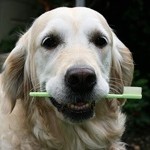Pet Dental Reminders
February is National Pet Dental Month in the United States. Did you know that in Australia it is recognized in August? This is a reminder that your pet’s oral health is as important as your own. According to the American Veterinary Dental Society (AVDS) up to 80% of dogs and cats over the age of 3 have some degree of periodontal disease. Less than 1% of the population brushes their dog’s teeth on a regular basis.
It can be easy to overlook your dog’s oral health on a day-to-day basis. This campaign is a great reminder to take care of your dog’s teeth now and all year round.
Many people think “doggie breath” is inevitable when in reality it is a sign of an oral problem. Plaque and tartar buildup can lead to serious oral problems such as gingivitis and periodontal disease. Those same bacteria can enter the blood stream, leading to heart disease or filter through the kidneys and liver. In addition, dental problems cause oral pain and can lead to infections and tooth loss. Dental disease can also cause loss of appetite, weight loss, and systemic diseases. Prevention is the cornerstone of canine dental health.
Just remember to use toothpaste specifically designed for cats and dogs (an enzymatic toothpaste is best because it decreases the work you have to do – even if the toothpaste comes in contact with the tooth, your pet still benefits from the procedure). Do not allow the pet to drink water or consume food other than the treat for approximately 20-30 minutes afterwards. This will allow the enzymes in the paste to benefit the teeth. Human toothpaste and baking soda are not good for dogs because they contain fluoride and ingredients that can cause gastrointestinal irritation or more significant problems in large amounts.
Starting early is always best, as puppies can get used to brushing more easily, but even old dogs can learn new dental tricks. Start by letting your pet taste pet toothpaste from your finger on several occasions. Then put some on their pet toothbrush to get them used to the texture.
When your pet is ready, (some dogs take days, others take weeks) gently rub your fingers on their gums and lips to get them used to the sensation. You can even start with peanut butter or cream cheese to begin this process so they will associate your fingers in their month with something very yummy. Continue to do this until your dog looks forward to this activity and then just start a good habit by doing it on a daily or weekly basis. Some type of schedule helps owners commit to doing it on a regular basis.
Chewing is great for dogs, helping to improve dental health by scraping away existing plaque and tartar. Give pets a better alternative than your slippers, such as a dental chew that activates the body’s natural defense system, killing plaque-forming bacteria. Just remember that they should not chew on anything harder than their tooth or it can cause a tooth to break (take it from me-I used to freeze marrow bones with peanut butter until my dogs chipped 2 of their teeth while gnawing on them). Now we just use kongs.
For dogs with bad breath, consider a breath spray that fights odors and controls tartar. Opt for something easy-to-use that has veterinary-strength potency. This is especially helpful in winter if your dogs enjoy frozen poopsicles.
Your vet should be checking your dog’s teeth at every visit to let you know if they see anything abnormal and if a dental cleaning is recommended, don’t ignore the advice of your veterinarian. It can add months and years onto a pet’s life by getting ready of tartar, plaque and bacteria trapped in the dog’s teeth and gums.
February is the month to visit your vet for an oral exam and cleaning in honor of National Pet Dental Health, however, regardless of the month, remember to keep those pearly whites sparkling and if you like doggie kisses, that breath fresh.

